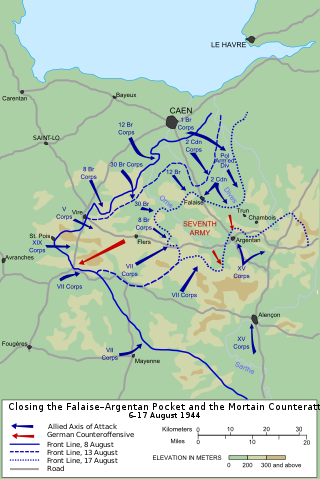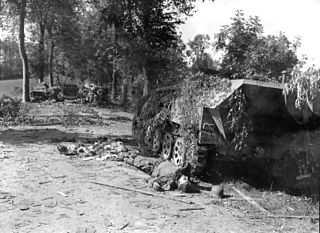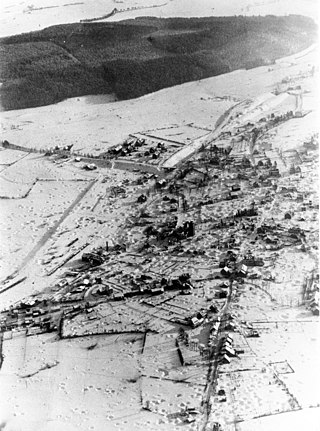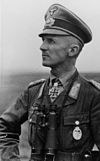History
On 17 November 1942, the Stab Nehring staff, assigned to the German general in Rome, was reformed to become the LXXXX Army Corps. This staff was soon repurposed to become the 5th Panzer Army. [1]
The 5th Panzer Army was created on 8 December 1942 as a command formation for armoured units forming to defend Tunisia against Allied attacks which threatened, after the success of the Allied Operation Torch landings in Algeria and Morocco. The army fought alongside the Italian First Army as a part of Army Group Afrika. The army capitulated on 13 May 1943, along with its commander Gustav von Vaerst.
Normandy
The army was reformed on 24 January 1944 as Panzergruppe West ("Panzer Group West"), the armoured reserve for Oberbefehlshaber West. The new army was placed under the command of Leo Geyr von Schweppenburg. The method of employment of Panzer Group West in the event of an allied invasion was the subject of much controversy, with OB West commander Gerd von Rundstedt and Army Group B commander Erwin Rommel favouring different methods. [3] Rundstedt and von Schweppenburg believed that the panzer group should be held in reserve some distance from the front, to counter-attack Allied penetrations. Rommel was convinced that Allied air power and naval artillery would not allow the Germans the freedom to move large formations and so insisted that the panzers should be deployed much closer to the front line. Adolf Hitler forced an unhappy compromise on the western commanders and refused to allow them to commit the panzer group without his authority. When the Allied invasion of France began on 6 June 1944, Panzer Group West remained immobile; by 8 June, Geyr had been able to rush three panzer divisions northward to defend Caen against British and Canadian forces. Geyr planned to launch the divisions in a counter-attack that would drive the British and Canadians back into the sea. On 10 June, Schweppenburg was wounded and most of his staff killed when the RAF attacked his headquarters at La Caine. Geyr's tank units managed to limit the British advance for another month but he was relieved of his command on 2 July, after seconding Rundstedt's request that Hitler authorize a strategic withdrawal from Caen. On 2 July he was replaced by Heinrich Eberbach. The panzer group fought against the Allied forces in Normandy, suffering heavy losses and eventually finding many of its divisions trapped in the Falaise Pocket. After the shattered remnants of the panzer group escaped from the pocket at the end of August, it began a retreat towards the German border.
Retreat, Ardennes
In August, the remaining elements of Panzer Group West were reorganized as the 5th Panzer Army, with a combat formation remaining in action under the title Panzer Group Eberbach. After a brief period under the Waffen-SS commander Sepp Dietrich, command of the army passed to Hasso von Manteuffel. The army saw heavy combat on the German border against Allied forces, the panzer divisions suffering heavily from Allied ground attack aircraft. In November the 5th Panzer Army began forming up in the Ardennes, alongside the newly formed 6th SS Panzer Army under Dietrich. Both formations took part in the Battle of the Bulge, the Fifth Panzer Army became the main central force advancing westwards from the pre-existing front lines after the planned schwerpunkt assigned to the Sixth Panzer Army was stopped at the Elsenborn Ridge and the Ambleve Valley. The Fifth Panzer Army suffered heavy losses in battles around Bastogne and in the armour battles around Celles and Dinant, the westernmost points of advance. After the offensive was cancelled, it continued its fighting withdrawal to the German border. In March, it was involved in efforts to eliminate the American bridgehead over the Rhine at the Ludendorff Bridge in Remagen. The 5th Panzer Army was encircled and trapped in the Ruhr Pocket, and surrendered on 17 April 1945.

Karl Rudolf Gerd von Rundstedt was a German Generalfeldmarschall in the Heer (Army) of Nazi Germany during World War II. Born into a Prussian family with a long military tradition, von Rundstedt entered the Prussian Army in 1892. During World War I, he served mainly as a staff officer. In the interwar period, he continued his military career, reaching the rank of Colonel General before retiring in 1938.

Operation Epsom, also known as the First Battle of the Odon, was a British offensive in the Second World War between 26 and 30 June 1944, during the Battle of Normandy. The offensive was intended to outflank and seize the German-occupied city of Caen, an important Allied objective, in the early stages of Operation Overlord, the Allied invasion of north-west Europe.

The Falaise pocket or battle of the Falaise pocket was the decisive engagement of the Battle of Normandy in the Second World War. Allied forces formed a pocket around Falaise, Calvados, in which German Army Group B, consisting of the 7th Army and the Fifth Panzer Army, were encircled by the Western Allies. The battle resulted in the destruction of most of Army Group B west of the Seine, which opened the way to Paris and the Franco-German border.

Operation Lüttich was the codename of the Nazi German counter-attack during the Battle of Normandy, which occurred near U.S. positions near Mortain, in northwestern France. Lüttich is the German name for the city of Liège, Belgium. In British and American histories of the Second World War, the German Operation Lüttich is known as the Mortain counter-attack, which Hitler ordered to regain territory gained by the First United States Army during Operation Cobra by reaching the coast of the Avranches region, which is at the base of the Cotentin peninsula, in order to isolate the units of the Third United States Army that had advanced into Brittany.

Freiherr Hasso Eccard von Manteuffel was a German baron born to the Prussian noble von Manteuffel family and was a general during World War II who commanded the 5th Panzer Army. He was a recipient of the Knight's Cross of the Iron Cross with Oak Leaves, Swords and Diamonds of Nazi Germany.

The Battle of Gazala was fought during the Western Desert Campaign of the Second World War, west of the port of Tobruk in Libya, from 26 May to 21 June 1942. Axis troops of the Panzerarmee Afrika consisting of German and Italian units fought the British Eighth Army composed mainly of British Commonwealth, Indian and Free French troops.

Heinrich Eberbach was a German general during World War II who commanded the 5th Panzer Army during the Allied invasion of Normandy. He was a recipient of the Knight's Cross of the Iron Cross with Oak Leaves of Nazi Germany.

Hans–Ulrich Freiherr von Luck und Witten, usually shortened to Hans von Luck, was a German officer in the Wehrmacht of Nazi Germany during World War II. Luck served with the 7th Panzer Division and 21st Panzer Division. Luck is author of the book Panzer Commander.
The 21st Panzer Division was a German armoured division best known for its role in the battles of the North African Campaign from 1941 to 1943 during World War II when it was one of the two armoured divisions making up the Deutsches Afrikakorps (DAK).
The 1st Panzer Army was a German tank army that was a large armoured formation of the Wehrmacht during World War II.

The 4th Panzer Division was an armored division in the Army of Nazi Germany.

Operation Charnwood was an Anglo-Canadian offensive that took place from 8 to 9 July 1944, during the Battle for Caen, part of the larger Operation Overlord in the Second World War. The operation was intended to capture the German-occupied city of Caen, which was an important objective for the Allies during the opening stages of Overlord. It was also hoped that the attack would forestall the transfer of German armoured units from the Anglo-Canadian sector to the American sector to the west, where an offensive was being prepared. The British and Canadians advanced on a broad front and by the evening of the second day had taken Caen up to the Orne and Odon rivers.
The 7th Panzer Division was an armored formation of the German Army in World War II. It participated in the Battle of France, the invasion of the Soviet Union, the occupation of Vichy France, and on the Eastern Front until the end of the war. The 7th Panzer Division is also known by its nickname, Ghost Division.

Friedrich Karl Albert Dollmann was a German general during World War II who commanded the 7th Army during the Invasion of France and the early phases of the Allied invasion of Normandy until his death in June 1944.

Leo Dietrich Franz Reichsfreiherr Geyr von Schweppenburg was a German general in the Wehrmacht during World War II, noted for his pioneering stance and expertise in the field of armoured warfare. He commanded the 5th Panzer Army during the Invasion of Normandy, and later served as Inspector General of Armoured Troops. After the war he was involved in the development of the newly built German Army (Bundeswehr).

The Ardennes Counteroffensive, commonly known as the Battle of the Bulge, was a massive military operation undertaken by Nazi Germany in southern Belgium and northern Luxembourg which lasted from 16 December 1944 until 25 January 1945. The intent of the offensive was to split the ground forces of the Western Allies from each other and encourage them to make peace with Germany, leaving all of Germany's military might to fight off the resurgent USSR.

The RAF raid on La Caine (1944) was an attack on 10 June 1944 by aircraft of the Royal Air Force against the headquarters of Panzergruppe West during Operation Overlord the Allied invasion of France, which led the German Panzer divisions in France and Belgium. The headquarters had recently taken over the château at La Caine, about 12 mi (19 km) to the south-west of the city of Caen, north of Thury-Harcourt.
The Westheer is the name given to the German Army fighting on the Western Front after 1941. The Oberbefehlshaber West was the largest command structure for the Westheer.

General der Panzertruppe was a General of the branch OF8 rank of the German Army, introduced in 1935. A General der Panzertruppe was a Lieutenant General, above Major General (Generalleutnant), commanding a Panzer corps.

The Battle of St. Vith was an engagement in Belgium fought during the Allied advance from Paris to the Rhine in World War II. It was one of several battles on December 16, 1944 constituting the opening of Germany's Ardennes counteroffensive.






















